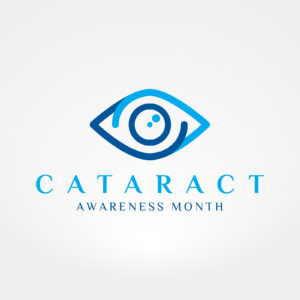
June Is Cataract Awareness Month
It’s Cataract Awareness Month! Did you know that more than half of all Americans will develop cataracts by age 80? In fact, cataract surgery is the most frequently performed surgical procedure in the United States. There are more than 1.5 million procedures performed each year. What are cataracts and why do so many Americans develop them?
In honor of Cataract Awareness Month, let’s look at some of the facts and fiction surrounding this common condition.
Fact or Fiction? Cataracts are caused when a film grows on the eye’s surface.

This is fiction. A cataract does not form on the eye, but rather within it. A cataract is a clouding or opacity of the eye’s lens. The lens is the part of the eye responsible for focusing light and producing clear sharp images. The cloudiness or “film” on the lens is a result of the cataract forming within the eye.
Fact or Fiction? “Overusing” your eyes will cause cataracts.
This is also fiction. Cataracts are not made worse by close work such as reading, sewing, watching movies, or looking at television. Those up-close activities can lead to a slew of other conditions if overdone, though. You can develop refractive errors, like myopia. And, you can experience headaches and eye strain from Computer Vision Syndrome. It’s not so much “overusing” as “using too much in the wrong ways”. If you’ll be spending many hours on the computer, make sure you take breaks often. The 10-10-10 Rule will help keep the eye strain at bay.
Fact or Fiction? You can “catch” a cataract from someone who has one.
This is clearly fiction! Cataracts are not contagious. They are, however, affected by genetics. If your parents and grandparents all developed cataracts in old age, you have a higher likelihood of also developing them. For people with cataracts in their family health, learning about cataracts and how to prevent them is key.
Fact or Fiction? Cataracts are caused solely by old age.
Fiction. Although most common in people over 60, cataracts can occur at any age. When cataracts occur in younger patients, they are usually caused by a chronic medical condition, eye trauma, or certain prescription drugs. Fetal exposure to infection, radiation, steroids, alcohol, and other substances of abuse during pregnancy are risk factors for congenital cataracts.
For adults, risk factors may include smoking, steroid use, and deficiencies in certain vitamins and minerals. Prolonged exposure to sunlight, specifically ultraviolet B (UVB), is a definite risk factor for cataracts. Medical conditions such as diabetes, myotonic dystrophy, or Wilson’s disease increase the risk for cataracts, regardless of age. Women and African Americans are at increased risk as well.
If you belong to a group with an increased risk, take extra precautions. Learn more about this condition and how to prevent it. What are cataracts? What causes them? How can I treat them? These are all questions to find the answers to. Then, adjust your activities and lifestyle habits based on your findings.
Fact or Fiction? Cataracts are painful and always lead to blindness.
Fiction. Cataracts form slowly and cause no pain. For most people, cataracts are a natural result of aging. Though they may lead to blindness when left untreated, “new techniques developed over the past decade have made cataract surgery one of the most successful procedures available in terms of restoring quality of life to patients,” according to Dr Steven Unterman of Mid-America Eye Center. You may experience some tenderness post-surgery, but cataracts themselves don’t hurt. If you catch them early enough and get them treated, you can avoid going blind.
Fact or Fiction? A cataract must be “ripe” before it is removed.
Fiction. Cataracts can take from a few months to several years to develop. Sometimes the cataract stops developing in its early stages, and vision is only slightly decreased. But if it continues to develop, vision is impaired and treatment is necessary.
The best time to have a cataract removed is when it starts to interfere with your quality of life. Symptoms of cataracts include:
- blurred, cloudy, filmy, or fuzzy vision
- distorted images or double vision in either eye
- a fading or yellowing of colors
- sensitivity to light and glare, especially while driving at night
- frequent changes in your eyeglass or contact lens prescriptions
You and your ophthalmologist should determine together when cataract surgery is right for you. You may want to try other methods to naturally improve your eye health first.
Fact or Fiction? Cataracts are removed using lasers.
Fiction. Doctors replace diseased tissue with an artificial device known as an intraocular lens implant. Cataract surgery is most often done as an outpatient procedure under local anesthesia. The patient generally goes home the same day, and because the incision is so small, many patients don’t even need stitches.
However, months or years after the cataract is removed, a thin membrane may develop behind the implant that needs to be opened with a laser. The procedure is quite common and may be one reason why some patients mistakenly believe that cataracts are removed with a laser.
Fact or Fiction? Cataracts can’t “grow back” after surgery.
Fact! This is the best news… Cataracts do not grow back, and most patients experience clearer vision right after surgery. In the odd case, a similar condition develops on the secondary lens which wasn’t removed during surgery. This is called Posterior Capsular Opacification and can cause a clouding in your eyes. Since this complication isn’t uncommon, there’s effective laser treatment available to fix it.
Cataract Awareness
With June being Cataract Awareness Month, all readers should make a point to acknowledge their eye health. What can you do to ensure you don’t develop cataracts later in life? How can you improve today? It’s easy to take good vision for granted when you’re young. But later, you’ll wish you had thought about it more. Hopefully, next June when someone asks, “what are cataracts?” you’ll be able to answer with flying colors.
For more information about cataracts and how you can prevent them and their progression, check out our in-depth articles about cataracts.
Our Rebuild Your Vision Ocu-Plus Formula Contains All 17 Vitamins, Minerals, and Herbal Supplements to Protect Against Cataracts!













Thank you for the information .
I was diagnosed having one cataract at the right eye ,two years ago .
I am in SOUTH AFRICA and I would like to try OCU-PLUS FORMULA .
Could you ,please,tell me where and how can I get it ?
Thank you .
Alice .
Hi Alice, thank you for writing in. I am very sorry to hear about your cataract. I have included a link below where you can find more information on our Ocu-Plus Formula, which will include a link where you can try out a bottle for free.
https://www.rebuildyourvision.com/eye-vitamins/
Please let me know if you have any other questions.
I would like to know what vitamins or what to do for a thinning optic nerve
great info – I agree with leaving off sun glasses and let sun go over eyes. Living in Oz we get plenty of sun. My issues are with high eye pressure and how to reduce it – have thick corneas so reading can be higher than most but still need to reduce pressure.